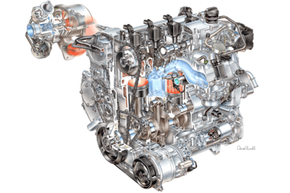When you think of flexing green muscle, the Incredible Hulk might first come to mind. But flex-fuel engines are another powerful green machine and, unlike the Hulk, they exist outside of comic books and movies.
Flex engines are found in flexible-fuel vehicles (FFVs), which are sold and operated in countries around the world. In short, a flexible-fuel vehicle is one that can run on fuels other than straight gasoline, such as ethanol or nearly any ratio of ethanol and gas combined in the same tank.
Advertisement
Consumers have had the option to buy FFVs in the United States since 1995. But Brazil is actually the world's biggest flexible-fuel vehicle market. More than 90 percent of vehicles sold today in that country have flex engines [source: Sugarcane.org].
In the United States, the flex fuel that's garnered the most headlines is E85. Depending on seasonal adjustments, E85 is a blend of up to 85 percent ethanol, with the remainder consisting of gasoline. As of this writing, approximately 2,300 United States fuel stations offer E85.
You can't pump E85 into a standard gasoline vehicle's tank without nasty side effects, such as chugging, rough performance and possible engine damage. Instead, you need an FFV designed specifically to work with the chemical corrosiveness and higher octane of ethanol.
Oddly, many consumers own FFVs and they don't even know it. For example, there are roughly 120,000 FFVs in the state of Nebraska and nearly 60 percent of the owners are unaware that they have a flex engine under the hood [source: Nebraska Corn Board]. The most obvious clues? If your car was manufactured after 2008 and it has a yellow gas tank cap, it's an FFV. Your owner's manual will also enlighten you as to your motor type.
Even people who don't know much about FFVs understand that oil consumption is a hot topic. That's where FFVs frequently enter the conversation. Because we can produce ethanol from renewable sources, such as corn and sugar cane, FFVs are often described as more eco-friendly than straight gasoline vehicles.
The supposed environmental friendliness of FFVs, however, is a point of hot contention between various factions in manufacturing, politics and science (more on that later).
On the next page, you'll read about how flex engines are different from their gasoline counterparts. You'll see that these two combustible engine cousins are more alike than you might think.
Advertisement


